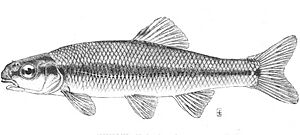Bluntnose minnow facts for kids
- "Bluntnose minnows" is also used for the genus Pimephales as a whole.
Quick facts for kids Bluntnose minnow |
|
|---|---|
 |
|
| Conservation status | |
| Scientific classification | |
| Synonyms | |
|
The bluntnose minnow (Pimephales notatus) is a small freshwater fish. It belongs to a group of fish called cyprinids, which includes many types of minnows. You can find these fish in many places across the eastern and central United States. They live from the Great Lakes area all the way down to Louisiana. They are also found east through the Midwestern United States to New York State. The bluntnose minnow is very common. It might even be the most common freshwater fish in the Eastern U.S.
Contents
What Does a Bluntnose Minnow Look Like?
Bluntnose minnows are usually about 6.5 centimeters (2.5 inches) long. The longest ones can grow up to 11 centimeters (4.3 inches). They have dark spots on the first few rays of their top fin. The scales between their head and top fin are smaller than the scales on the rest of their body.
Special Features of Their Body
These fish have a rounded head. Their mouth is at the very front, but their snout hangs a little bit over it. The dark edges on their scales make their body look like it has a cross-hatched pattern. Their scales are called cycloid scales. Scientists can tell how old a fish is by looking at the rings on these scales.
How to Tell Them Apart
A special line, called the lateral line, runs from their head to their tail. This line ends in a black spot. This black spot helps you tell them apart from the fathead minnow. Bluntnose minnows have a pale olive color on their upper body. Their lower body is silvery. The scales near their lateral line have a silvery-blue shine.
Where Do Bluntnose Minnows Live?
You can find bluntnose minnows in North America. They live in the Hudson Bay and Mississippi River river systems. Their home range goes from southern Quebec in Canada down to Louisiana in the United States. They are also found from the Saint Lawrence River in Quebec to the Roanoke River on the east coast of the U.S.
New Homes for Minnows
Bluntnose minnows have also been found in new places. These include Connecticut, Georgia, Maryland, Massachusetts, New York, Ohio, South Dakota, Utah, Virginia, West Virginia, and Michigan. People think these fish were introduced by accident. This might have happened when people released bait buckets. Or, they might have been mixed in with other fish stocks. These minnows are thought to be the most common freshwater fish in the eastern part of the country.
What Kind of Places Do They Like?
Bluntnose minnows live in many different water bodies. You can find them in lakes, rivers, ponds, and streams. They prefer shallow, clear water with a sandy bottom. Their homes can be anything from swampy areas and springs to larger rivers and lakes. Sometimes, many different kinds of minnows can live together in one medium-sized stream. These fish can swim alone or in large groups.
What Do Bluntnose Minnows Eat?
These fish enjoy eating small water insects. They also munch on algae and tiny plant-like organisms called diatoms. Their diet includes insect larvae that live in water. They also eat small crustaceans called entomostracans. Sometimes, they might eat fish eggs or very small fish.
Life Cycle of the Bluntnose Minnow
Bluntnose minnows lay their eggs from early spring to midsummer. The exact time depends on where they live. They dig small dips under stones and attach their eggs there.
Changes During Mating Season
During the mating season, male bluntnose minnows change. Their heads become darker, and their bodies turn bluish. They also grow three rows of small bumps, called tubercles, on their heads. The eggs usually hatch in about eight to fourteen days.
About Their Name
The scientific name for the bluntnose minnow is Pimephales notatus. The genus name Pimephales means "fat head." The specific name notatus means "marked" or "spotted." This describes some of their features.


